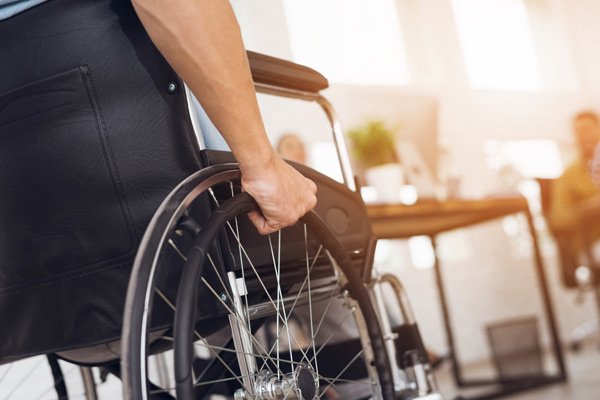People with disabilities face enough hardships in their life. Not only may they experience difficulty getting around or completing tasks compared the average person, but they may also deal with mental struggles and the stigma society holds against their own abilities. Yet, research also shows that individuals with disabilities are much likelier to face yet another hardship: food insecurity.
First, it is important to understand that there is no single best definition of disability, considering that it can encompass a wide variety of conditions. Disability, however, generally refers to a medical condition or health impairment that limits participation in usual roles or activities. The U.S. Census Bureau uses 6 different sub-definitions to account for the variations. This includes those with a hearing disability, visual disability, mental disability, physical disability, self-care disability (such as difficulty dressing or bathing), and going-outside-home disability (such as difficulty doing errands alone due to a physical, mental, or emotional condition). The government has made an effort to conduct more surveys in order to adequately assess what kinds of disabilities are most prevalent.

Therefore, it is evident that disability can affect anyone at any point in life, and, consequently, can create severe economic hardships. One study found that after the onset of a severe or chronic disability, average earnings fall by 76%. With minimal earnings, it makes it difficult to afford basic life necessities such as food. People with disabilities are at least twice as likely to live in poverty and struggle to put food on the table compared to those who do not have disabilities. Furthermore, half of food insecure households that include adults with disabilities experience “very low food security” compared to the one-third of all food-insecure households.
Why is it that individuals with disabilities are facing economic struggles? According to the U.S. Census Bureau, only 41.1% of working-age adults with disabilities are employed compared to 79% of those without disabilities. Furthermore, there is a disconnect between the expenses required for those with disabilities and the unemployment rate facing them. A study conducted by Mathematica Policy Research found that it would require 2 1/2 times the income of an able-bodied person to have the same likelihood of food insecurity. Expensive equipment, such as wheelchairs, specialized telephones, and other healthcare related expenses may increase the likelihood of food insecurity, even though those purchases may relieve some symptoms or barriers that those individuals face.

While individuals with disabilities who face food insecurity consequently face difficulties, there are measures in place to aid them. Several safety nets that exist include SSI (Supplemental Security Income), SSDI (Social Security Disability Insurance), Medicare, Medicaid, and SNAP (Supplemental Nutrition Assistance Program). Both SSI and SSDI are administered through the Social Security Administration, however, the two programs have important distinctions. SSDI is a type of insurance meant to partially replace wages that were lost due to the onset of a disability. In order to reap the benefits of SSDI, a person must present their work history. More specifically, a worker must have worked at least a fourth of his or her adult lifetime and at least 20 quarters in the 10 years before the disability. On the other hand, SSI, or Supplemental Security Income, is more inclusive as it is a means-tested welfare program that requires no work history. Therefore, it is available for low-income children, adults, and seniors. In some cases, adults can receive both if their SSDI benefits are low enough.
Another safety net that is often overlooked but is extremely beneficial for those with disabilities is the SNAP program, previously known as food stamps. SNAP helped more than 44 million low-income Americans afford a nutritionally adequate diet in 2016. In terms of those facing a disability, SNAP has had profound advantages for their lives as well. One in 4 SNAP participants have a functional or work limitation or receives federal government disability benefits. Furthermore, research has proven that SNAP works—it has lifted many out of poverty, helps families put food on the table, and improves health and economic outcomes.
Nonetheless, the SNAP program has some faults as well that need to be addressed. First, SNAP uses a different set of questions to assess disabilities compared to those that are asked by the U.S. Census Bureau. Questions that are asked by the SNAP program tend to be vague and exclude questions about whether an individual is currently covered by SSI and SSDI programs. This, consequently, can exclude many individuals with disabilities from receiving necessary benefits for years. Furthermore, it excludes several groups of individuals with disabilities such as those who have not received SSI or SSDI benefits nor interim assistance. Therefore, if someone with a recent onset of disabilities is waiting to receive a determination for these other programs, they cannot qualify to receive food assistance.
In order to provide more assistance to those with disabilities facing food insecurity, several measures can be taken. First, SNAP can be modified to be more inclusive towards those with disabilities. It has been suggested by authors of one study that SNAP should ensure that individuals with disabilities are able to receive full accommodations during the application process to avoid hunger. Furthermore, more work opportunities can be provided for those with disabilities. Research has shown that adults with disabilities are less likely to remain employed consistently and are significantly more likely to experience prolonged unemployment that exists over 12 months. This result may exist due to existing stigmas towards those with disabilities that they may be less equipped than others to perform tasks. However, managers should be aware during a hiring process of this stigma and the legal repercussions they face if they demonstrate discrimination. Furthermore, existing safety nets in place need to be more inclusive in order to further assist the monumental expenses that those with disabilities face.
You can get involved, too. Take the first step by hosting a food drive in your community. Learn more about how Move for Hunger can help you start planning your event today.
